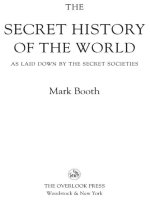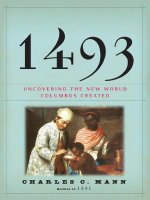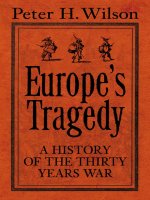Ted gup a secret gift (v5 0)
Bạn đang xem bản rút gọn của tài liệu. Xem và tải ngay bản đầy đủ của tài liệu tại đây (1.29 MB, 218 trang )
Table of Contents
Title Page
Copyright Page
Dedication
Epigraph
I. - A Christmas Carol
The Offer
Mr. B. Virdot’s Story: The Suitcase
II. - In Consideration of the White Collar Man
A Man of Means
Blizzard
Hello Bill
Gassed
Mr. B. Virdot’s Story: The Promise
III. - The Bread of Tomorrow
Beginning Again
Grief
Bad Company
A Lynching
Legacy of Lies
Mr. B. Virdot’s Story: The Crossing
IV. - If I Would Accept Charity
Oppression
Sooner Starve
Dandelions and Pencils
Shame
The Seeds of Resentment
Left Behind
Gumption
So Little for Women
A Foreigner No Longer
V. - Families
“As Good as the Best”
The Pump
Plantation
Asylum
VI. - Families
Black Hand Gang
Defeated
Nomad
Mr. B. Virdot’s Story: Betrayal
VII. - An Opportunity to Help
A Dog Named Jack
The Milk of Human Kindness
“Too Big-Hearted”
Shipmates
Doctors
Mr. B. Virdot’s Story: A Second Gift, 1940
VIII. - A Merry and Joyful Christmas
The Doll
A Special Time
The Pony
The Unexpected
Mr. B. Virdot’s Story: The Bridge
IX. - True Circumstances
Final Reflections
Epilogue: Canton Revisited
Acknowledgements
Author’s Note
Mr. B. Virdot: A Timeline
Index
About the Author
ALSOBY TED GUP
The Book of Honor:
Covert Lives and Classified Deaths at the CIA
Nation of Secrets:
The Threat to Democracy and the American Way of Life
THE PENGUIN PRESS
Published by the Penguin Group
Penguin Group (USA) Inc., 375 Hudson Street, New York, New York
10014, U.S.A. • Penguin Group (Canada), 90 Eglinton Avenue
East, Suite 700, Toronto, Ontario, Canada M4P 2Y3 (a division of Pearson
Penguin Canada Inc.) • Penguin Books Ltd, 80 Strand, London WC2R 0RL,
England • Penguin Ireland, 25 St. Stephen’s Green, Dublin 2, Ireland
(a division of Penguin Books Ltd) • Penguin Books Australia Ltd, 250 Camberwell
Road, Camberwell, Victoria 3124, Australia (a division of Pearson Australia
Group Pty Ltd) • Penguin Books India Pvt Ltd, 11 Community Centre,
Panchsheel Park, New Delhi - 110 017, India • Penguin Group (NZ),
67 Apollo Drive, Rosedale, North Shore 0632, New Zealand
(a division of Pearson New Zealand Ltd) • Penguin Books (South Africa)
(Pty) Ltd, 24 Sturdee Avenue, Rosebank, Johannesburg 2196, South Africa
Penguin Books Ltd, Registered Offices: 80 Strand, London WC2R 0RL, England
First published in 2010 by The Penguin Press, a member of Penguin Group (USA) Inc.
Copyright © Ted Gup, 2010
All rights reserved
LIBRARY OF CONGRESS CATALOGING IN PUBLICATION DATA
Gup, Ted, date.
A secret gift : how one man’s kindness—and a trove of letters—revealed the hidden history of the Great Depression / Ted Gup.
p. cm.
eISBN : 978-1-101-44463-4
1. Canton (Ohio)—Biography. 2. Canton (Ohio)—Economic
conditions—20th century. 3. Canton (Ohio)—History—20th century.
4. Stone, Samuel, 1887-1981. 5. Benefactors—Ohio—Canton—Biography.
6. Benevolence—Ohio—Canton—History—20th century. I. Title.
F499.C2G87 2010
977.1’62—dc22
2010017302
Without limiting the rights under copyright reserved above, no part of this publication may be reproduced, stored in or introduced into a
retrieval system, or transmitted, in any form or by any means (electronic, mechanical, photocopying, recording or otherwise), without the
prior written permission of both the copyright owner and the above publisher of this book.
The scanning, uploading, and distribution of this book via the Internet or via any other means without the permission of the publisher is
illegal and punishable by law. Please purchase only authorized electronic editions and do not participate in or encourage electronic piracy
of copyrightable materials. Your support of the author’s rights is appreciated.
For my mother, Virginia,
Her sister, Dorothy,
And in Memory of Minna and Sam
And the Good People of Canton, to whom so much is owed
Other states indicate themselves in their deputies—but the genius of the United States is not best or most in its executives or
legislatures, nor in its ambassadors or authors, or colleges or churches or parlors, nor even in its newspapers or inventors—but
always most in the common people, south, north, west, east, in all its states, through all its mighty amplitude.
—WALT WHITMAN , 1855
It was the ordinary pities and fears consumed us.
We gathered on porches; the moon rose; we were poor.
What audience would ever know our story?
Beyond our windows shown the actual world.
We gathered on porches; the moon rose; we were poor.
And time went by, drawn by slow horses.
Somewhere beyond our windows shown the actual world.
The Great Depression had entered our souls like fog.
—FROM “PANTOUM OF THE
GREAT DEPRESSION , ”
DONALD JUSTICE
I.
A Christmas Carol
The Offer
[Christmas is] the only time I know of, in the long calendar of the year, when
men and women seem by one consent to open their shut-up hearts freely, and
to think of people below them as if they really were fellow passengers to the
grave, and not another race of creatures bound on other journeys.
—CHARLES DICKENS , A CHRISTMAS CAROL (DECEMBER 1843)
It was Sunday, December 17, 1933, a cold and drizzly day, when B. Virdot’s plan began to take
shape. That evening, outside the First Presbyterian Church, beneath its soaring twin battlements,
hundreds of families gathered. Parents took their children’s hands and climbed the wide sandstone
steps to enter the gothic sanctuary. Here, at the center of this beleaguered city, the faithful had come
for generations. President William McKinley himself had been married here. But on this night, they
assembled to hear a reading of Charles Dickens’s A Christmas Carol. It was a tradition of long
standing, but during this bleak holiday season, it took on special meaning. Pressed shoulder-toshoulder in the stiff-backed pews, they were drawn from every corner of the city: church elders, men
and women of privilege, jobless millworkers, tradesmen forced to sell their tools, bankrupted shop
owners, widows trying to hold on to their children.
At the front of the sanctuary was a crèche with the baby Jesus, and around it, stunted pine trees
festooned with tinsel and glistening ornaments. Festive greenery hung from the choir loft above. For
many of these children it was all the Christmas they would see. They listened as Dr. Delbert G. Lean,
professor of oratory from nearby Wooster College, read of the miserly Ebenezer Scrooge, of the
ghosts that tormented him, and of a gift that transformed one poor family’s Christmas. Only one who
had lived such a life—who had lost his home, seen his father tossed in debtor’s prison, and been
pressed into factory labor as a child, as Dickens had—could understand what such a tale might mean
to these congregants.
Malnourished parishioners must have salivated to hear the words “There never was such a goose .
. .” and fought back tears as Tiny Tim proclaimed, “God Bless us, everyone.” They too hungered for
someone to bless them with a Christmas dinner, to lift them, if only for a moment, out of their misery.
Then, one by one, they shuffled past the Reverend James Wilson Bean, steeling themselves against a
frigid night and, for many, an empty cupboard.
The pastor too returned to his home, which, like many, had grown accustomed to the soft knock of
the hoboes and the homeless, hoping that a walk needed shoveling or a step, mending—in exchange
for a sandwich and a cup of coffee. Some members of the church’s board would have been glad to be
rid of Bean. His outspoken sympathies for the poor were fine, but at that moment the church could ill
afford to think of anything but its own survival. Bean’s pay had been cut. The “benevolences,” as the
fund for the needy was called, had been slashed. Church accounts had been frozen with the failure of
the Dime Savings Bank in October 1931, forcing it to make do with the few dollars left in petty cash.
Attendance was plummeting. Even among the stalwarts, some were losing faith—in themselves, in
one another, and in God.
Christmas was a week away, but for many, it meant just another day to get through. For four years,
Canton’s 105,000 citizens had been battered by the Great Depression. Around town, parents were
using strips of tires to extend the life of worn-out shoes, the union mission was bursting with the
homeless, and scrawny children in patched coats were scavenging for coal along the B&O Railroad
tracks. Many of those lucky enough to still have homes had sold the furniture, beds and all, and
huddled together on bare floors or sat on old orange crates. So it was around the country. And B.
Virdot saw it all.
Newspapers, selling for three cents a copy, were shared, family to family, and read by kerosene
lamp. For many, electricity was a luxury as remote as a ride on the bus or a visit to the doctor.
Children went to school on empty stomachs. Many would not learn the meaning of the word breakfast
until years later. In back alleys, dogs and cats were left to fend for themselves and could be seen
pawing through refuse for scraps. Thousands of Canton’s depositors were shocked to discover their
banks padlocked, their savings gone. Mothers and fathers did what they could to hide their despair
from the children—and from each other. All the while, the asylum, the county poorhouse, the city
orphanage, and the reformatory swelled with the casualties of the Hard Times. It was a landscape
Dickens would have recognized.
Far off in Washington, a new president had proclaimed earlier in the year that “the only thing we
have to fear is fear itself.” In Canton, and across the country, it didn’t feel that way. By Christmas
1933, two million Americans were homeless. Tens of thousands rode the rails in search of a job. One
in four Americans was out of work. In Ohio, it was worse. There the jobless numbered more than one
in three. And in industrial centers like Canton some put the number at 50 percent. There was no
purpose in counting. No relief was to be had.
Until then, Canton had always been a proud city where skilled and unskilled hands alike had found
opportunity. Its immigrant-rich labor pool, the centrality of its location, the convergence of railroads,
and the richness of its mineral deposits had given rise to major industries, like Hoover, Timken,
Diebold, and Republic Steel. The sweepers, roller bearings, safes, and steel they produced could be
found worldwide. Now some forges were idle and cold. Many assembly lines were reduced to
skeleton crews that went through the motions of maintenance, turning out the lights, and going home.
Like towns and cities across the land, Canton was sinking fast, mired in a systemic failure so
pervasive that it bred more resignation than revolution. No institution existed—neither government,
church, nor charity—to stem the misery. Bankruptcies mounted. Families were evicted over and over
and over again. To some in this city notorious for graft and vice—by one count it had 108 brothels,
outnumbering even its churches—it seemed that crime alone flourished. Dubbed “Little Chicago,” its
corruption-fighting city editor had been gunned down by the mob seven years before. His posthumous
Pulitzer couldn’t save the dying newspaper.
That Christmas of 1933 was a time when consumption meant TB, not a shopping spree, and the
stigma of the dole was as hard to face as hunger itself. Prohibition had ended two weeks earlier, but
who could afford a drink? Nothing was thrown out, and a new product called Scotch tape helped
mend the torn and tattered. The Lone Ranger premiered on radio, bringing a masked outsider to the
rescue of communities unable to save themselves. Even the weather had turned against them. That
Friday, two days before the Dickens reading, a freakish storm had pummeled Canton. Its torrential
rains set a record, and its lightning and thunder filled the December skies with an anger rarely seen so
late in the year.
“Do you think we will get out of this Depression just because we got out of all the others?” asked
humorist Will Rogers. “Lots of folks drown that’s been in the water before.”
NO ONE UNDERSTOOD the Hard Times better than Mr. B. Virdot. And so, that same Sunday,
December 17, 1933, he arranged to have an ad placed in the Monday morning edition of the Canton
Repository . It was no bigger than a playing card and appeared on page 3. And there, it might have
gotten lost above an ad for Blue Arrow gasoline and next to a story in which scientists touted the
prowess of the “tiny gene.” But the ad was not lost. A mere 158 words, it would catch the eye of the
entire town, be passed from household to household, then spread by word of mouth well beyond,
making news as far away as New York. It read in full:
IN CONSIDERATION OF
THE WHITE COLLAR MAN!
Suppose if I were confronted with an economic situation where the bread of tomorrow is the problem
of today—there is a question in my mind if I would accept charity directly offered by welfare
organizations. I know there are hundreds of men that are confronted with economic problems and
think, feel and act the same way.
To men or families in such position the maker of this offer, who will remain unknown until the very
end, will be glad if he is given an opportunity to help from 50 to 75 such families so they will be able
to spend a merry and joyful Christmas.
To such men or families that will request such financial aid, the writer pledges that their identity
will never be revealed. Please write:
B. VIRDOT,
GENERAL DELIVERY,
CANTON, OHIO
In writing, please familiarize me with your true circumstances and financial aid will be promptly
sent.
Even before the ad appeared, it created such a stir in the newsroom that the editors decided to
write a front-page story about the offer, assuring it citywide attention. The headline read: MAN WHO
FELT DEPRESSION’S STING TO HELP 75 UNFORTUNATE FAMILIES: ANONYMOUS GIVER,
KNOWN ONLY AS “B. VIRDOT,” POSTS $750 TO SPREAD CHRISTMAS CHEER. The story
noted that five years earlier—before the crash and the Depression—the benefactor had enjoyed all
the comforts of life and “money poured in.” Then the Hard Times caught up with him. Two years
earlier—1931—he was broke and “headed into bankruptcy.
“But there were friends who believed in him,” the story went on, “and creditors who had
confidence that he would come back. He hung on, and fought.” The story was a Depression-era
parable of the Good Samaritan and a plea to others not to give up. There was also an ominous
reference to the donor’s “remembrance of much darker days.” Just how the writer knew this much of
the donor is unclear. Perhaps he was privy to the secret, or perhaps some intermediary shared this
information with him.
The gift, the paper explained, was meant for those who might otherwise “hesitate to knock at
charity’s door for aid.” Such hesitation went beyond the stigma attached to accepting charity.
Canton’s streets, like those of other Depression-era towns, teemed with grifters and con artists. An
offer like B. Virdot’s was sure to draw as much suspicion as hope. Was this stranger who hid behind
a false name really on the up-and-up? To the skeptics, the paper offered words of reassurance: “This
is a genuine Christmas gift, involving no strings and no embarrassment to the recipients.”
“The name, ‘B. Virdot,’ is of course, fictitious,” the paper observed. “Perhaps the name ‘Kris
Kringle’ is fictitious too, but the genuineness of the spirit of giving he represents has never been
questioned.”
Not surprisingly, within two days, the post office was deluged with letters addressed to “Mr. B.
Virdot, General Delivery, Canton, Ohio.” And though the offer was specifically addressed to the
“White Collar Man,” it ignited a wave of appeals from men and women alike, from the elderly and
from children. There was Harry Stanley, a blacksmith out of work for two years, who hoped his five
small children might have something for Christmas; there were James Burson, a cook whose last job
was in July 1931, and Dan Jordan, a Timken Company policeman whose pay and hours had been
slashed and who fretted about his four children, two of whom were deaf; there was Joe Rogers, an
unemployed janitor, and Charles Minor, a jobless steeple-jack living on bread and coffee; there was
Ervin Neiss, a pipe fitter swamped by hospital bills and locked out from his own life savings by the
American Exchange Bank, and Ethel Dickerhoff, a mother of nine whose husband was a plumber with
no work in sight.
The letters came from every walk of life—from a roofer, a car dealer, a locksmith, a millworker, a
carpenter, a stonecutter, a musician, a grocer, a farmer, an ex-con, a butcher, a bell captain, a roofer,
a railroad man, a cobbler, a bricklayer, a bookie, a pastor’s assistant, and an array of fallen
executives that read like a Who’s Who of city notables. In a postscript, former bookkeeper Richard E.
Anderson wrote, “I am an office man.” But by then he’d been reduced to years of odd jobs. And there
were children who secretly took up their pens and pencils and asked on behalf of parents too proud to
seek help themselves, children like twelve-year-old Mary Uebing, whose widowed mother was
trying to feed six.
How many letters came in—whether it was hundreds or thousands—no one knows. And true to his
word, within days, the shadowy B. Virdot sent out the promised checks, all of them arriving before
Christmas. Initially he had intended to send ten dollars to some seventy-five families, but he found
himself unable to turn away so many worthy appeals, so he doubled the recipients and halved the
amount to five dollars. Today, five dollars doesn’t sound like much, but back then, it would have been
worth closer to one hundred dollars. For many, it was more than they had seen in a long time. In 1933,
you could get a loaf of bread for seven cents, a pound of ground beef for eleven cents, a dozen eggs
for twenty-nine cents. Eighteen cents bought a gallon of gas. The newly passed minimum wage was
thirty-three cents, but many counted themselves lucky to make a dollar a day.
B. Virdot never imagined his modest checks would reverse the course of the Great Depression, but
they did allow for many a child to go to bed with a full stomach, for presents to miraculously appear,
for enough coal to heat the house that week and into the next, and some token payment for the family
doctor who’d looked after a son’s polio, a daughter’s jaundice, or a father’s tuberculosis. Given that
many families had six, seven, or eight children, the 150 checks cumulatively reached a wide swath of
Canton’s neediest.
But B. Virdot’s gift was more than just a long shot at a lottery. It raised the spirits of thousands
with the knowledge that someone—one of their own—cared. He had invited them to share with him
their years of pent-up grief, disillusionment, and feelings of worthlessness, burdens that could not be
shared with loved ones without the risk of breaking their spirits. That Christmas, even those B. Virdot
did not choose received more than a glancing blessing from his gift.
But who was this B. Virdot? There must have been rampant speculation. Perhaps the donor was
one of Canton’s millionaires, a Hoover, a Timken, or some other highborn son of privilege able to
ride out the Depression in style. But they had not known any such “darker days,” as hinted at in the
Repository. Perhaps, then, he was a man of the people, someone more like themselves who had also
suffered. Had he perhaps been sitting there amid the congregants of the First Presbyterian Church,
himself moved by Dickens’s tale of redemption? Perhaps he belonged to St. John’s, the nearby
Catholic church. The deed itself shed little light on the man. But it was so Christian an act, this gift,
with its wish that its recipients have a “merry and joyful Christmas.” Whoever he was, he must surely
be a person of faith to shore up the faith of so many. And what had he endured—again, that reference
to “darker days”—that he could understand so well what so many in government and charities did not
—that those without were not without pride?
For seventy-five years, B. Virdot’s identity remained a secret. The letters seemingly vanished and
B. Virdot went quietly to his grave, joined in time by all who had written to him. But the mystery
surrounding his gift lingered: Who among so many needy had been chosen for such a gift? Did it make
any difference in their lives? Who was B. Virdot and why all the secrecy? Finally, what in his own
life had so moved him to make such a gift?
In the decades that followed, Canton once again enjoyed the blessings of prosperity. The factories
boomed once more, the forges glowed, and the vacant storefronts came back to life. For many,
Christmas became a time of overindulgence, when presents were piled high and food and drink were
in abundance. Memories of the Hard Times grew mercifully dim, but so too did its lessons. Three
generations later, it was as if none of it had happened—the Great Depression and B. Virdot’s gift
both seemed beyond remote, mere figments of that collective imagination called “history.”
And there, this tale might well have ended, but it did not.
Mr. B. Virdot’s Story: The Suitcase
June 24, 2008. That day, my son Matt and I drove three hours from our log cabin in Bucksport,
Maine, south to Kennebunk, to surprise my mother, Virginia. It was her eightieth birthday. After
dinner, she took us to her storage room under the attic eaves. There was something she said she
wanted me to have. I stood in the center of the room, surrounded by the artifacts of her downsized life
—a century-old brass cash register, a bronze stand for umbrellas and walking canes, an ivory mahjongg set, a crated chandelier. She made straightaway for an old black suitcase that lay on a shelf,
wedged between Grandfather’s adding machine and some Pyrex dishes. On top of it was a box of
memorabilia and a wooden case of serving cutlery.
Mother freed the suitcase from its niche and set it on the floor. Inside, she said, were some “old
papers”; exactly what, she did not know. But she knew about my interest in family history and my
passion for research and, eager to clear out storage space in the cramped attic, she’d decided to make
a present of the suitcase. Twice widowed, she had begun to pare away her belongings, not wishing to
leave my sister Audrey and me with the sort of monumental cleanup she’d faced when her mother,
Minna, passed three years earlier.
Like me, Minna was a pack rat. Both of us were teased for our inability to throw anything away.
We were the family archivists. For us, every old scrap of paper—be it a canceled check, the stub of a
movie ticket, a book of unused World War II ration stamps—held a narrative that could fill an
afternoon. Clearing out the detritus of Minna’s ninety-seven years fell to her two surviving daughters,
who had neither the time nor the patience to sift through the thousands of pages she’d accumulated.
Much of it went out with the trash. That the suitcase and its contents escaped this fate was something
of a miracle.
The next morning I loaded the suitcase, unopened, into the car, along with our backpacks and gear,
and returned to the cabin. I slid the suitcase under my bed, where it remained for days. Then, one
evening, I remembered it, and placed it on my bed. I studied it for a moment. But for a few bruises, it
looked to be in decent shape. The corners were frayed and there were places where the faux leather
had been scraped clean down to the gray boarding underneath, but the hinges were strong and the
latches retained their snap. The suitcase measured eleven by eighteen inches and was six inches deep,
with a black leather handle, pebbled to the touch. It was too big to be a briefcase, too small to be of
much use as luggage.
Taped to the top of the suitcase was a four-by-six-inch piece of paper, with notes written in faded
blue ink in my grandmother’s hand: “Memoirs: Minna’s Baby Book, etc., Mother and Father, Sam’s
Clippings and Pictures, Sampler, Baby Dress, Wedding Book, Family Misc.” Beside one latch was a
blue tag, evidence that it had once been shipped by Allied. It was one of a dozen moves the suitcase
had endured on its journey from Canton to Miami to Kennebunk.
I popped open the latches. It released a musty smell, a mix of old papers, decayed suitcase lining,
and air long trapped within. The top inside of the case had five yellowed pockets of varying sizes,
each with a snap. I imagined what each might have held in its day—perhaps a brush, a comb, a
mirror, a nail file, tweezers. The suitcase was crammed with old papers, stacked tightly, one upon the
other.
On top was a large and tattered ten-by-thirteen-inch yellow envelope written in my grandfather
Sam’s hand: “PERTANING XMAS GIFT DISTRIBTION.” He never was much for spelling.
Inside the packet was a tight sheaf of letters. I withdrew a handful. All of them were dated
December 18, 1933—the week before Christmas. Among the letters I found a tiny black passbook
from Canton’s George D. Harter Bank. It recorded a single deposit of $750. There were also some
150 canceled checks, each neatly signed “B. Virdot.” I had no idea what to make of any of it. The
name “B. Virdot” sounded vaguely familiar, but why, I did not know. Even by my grandmother’s
standards of hoarding, this collection of papers—canceled checks, all of them for five dollars, the
passbook with an account opened and emptied within a week, the mass of letters—seemed unworthy
of saving. Perhaps, I speculated, they were remnants of some exotic Christmas promotion my
grandfather had staged at his clothing store.
I skimmed the first lines of a few of the letters but the handwriting was poor and put me off. I soon
lost interest in them, distracted by more recognizable treasures—my grandmother’s baby book, letters
from Sam and Minna’s courtship, dozens of faded black-and-white photos from the 1920s and 1930s,
files from my grandfather’s business. The hours passed. It grew late and I was tired. I gathered up the
contents of the suitcase, which now lay scattered across my bed, and set them back in the suitcase in
the order in which I had found them, placing the packet of letters to this stranger, Mr. B. Virdot, back
in its original position on top of all else. I then closed the suitcase, fastened the latches, and slid it
back under my bed. I promptly forgot about it.
Then, some days later, I found myself again sorting through the suitcase, but this time I was drawn
to the envelope marked “PERTANING XMAS GIFT DISTRIBTION.” This time I withdrew all the
letters. There appeared to be a couple hundred. They were in no particular order, but someone—
presumably my grandmother—had gone to some trouble to keep them all carefully together and safe. I
began to read through them, beginning with those that looked most legible. They spoke of hunger and
cold, of endless searches for work, of dead ends and growing doubts. I was startled by their candor
and disturbed by the grim terrain they described. The street names and landmarks were all familiar to
me. The writers poured their hearts out to this B. Virdot, describing their anguish in such detail that it
made me uncomfortable, as if I were peering through a keyhole into the misery of strangers, or
eavesdropping on others’ prayers. How, I wondered, had these letters and their appeals found their
way into my grandparents’ hands?
It was then that I found, folded into quarters, a front-page section of the Canton Repository dated
December 18, 1933. The paper was yellowed and torn at the edges. I gently unfolded it and set it on
the bed, searching the page for some reference to my grandparents. There was none to be found. There
was a story about a fatal car crash and another about two freighters caught in a Pacific gale. There
was an account of a steel strike and a brief note about a burglary that netted the robbers twenty-five
dollars. But there was nothing to link any of this to my grandparents.
Then I noticed, at the bottom of the page, with a tear running up the center of the story and
dissecting the headline, an account of a mysterious donor named “Mr. B. Virdot.” As I read it, I felt a
cold shiver pass up my spine. The contents of the envelope, the letters, the canceled checks, all began
to fall into place. I searched for B. Virdot’s offer referred to in the story but could not find it. I
searched again and again. Nothing. Finally, my eyes fell upon it on page 3, a tiny ad so easily missed
it seemed a wonder anyone found it. I read it over twice and then again. Here, before me, the seventyfive-year-old secret had been revealed.
B. Virdot was my grandfather. His name was Sam Stone.
THAT EVENING I called my mother to share my discovery, but it was something she had known her
entire adult life. Her mother had let her in on the secret when she was considered old enough to honor
Sam’s wish and to keep it in the family. The moniker “B. Virdot,” she said, was constructed from the
names of Sam and Minna’s three daughters: Barbara, Virginia, and Dorothy, known as “Dotsy.” My
mother was the “Vir” in “B. Virdot.”
She also explained why the name sounded familiar. In the late 1930s and early 1940s, when the
three girls were not yet teenagers, Sam would take them jetting across Turkey Foot Lake in his sleek
twenty-seven-foot Chris-Craft Custom Runabout, with its varnished mahogany and 350-horsepower
engine. Just above the waterline was stenciled the boat’s name—The B. Virdot . It was a county away
from Canton and no one made the connection between the name and the mystery donor of years
earlier. He liked such inside jokes, parading before the world clues to his identity that only he could
decipher. That was where I had heard the name B. Virdot, from stories about the speedboat and my
mother’s halcyon summer days on the lake.
But in 1933, when my mother was just five, she had known nothing of her father’s gift. Preserving
the secret had been critical to its success. Many of those who wrote to B. Virdot were known to Sam
Stone, as he was known to them. He passed them on the streets, frequented the same restaurants and
shops, and sent his daughters to school with their children. In his store he measured their sleeves,
cuffed their pants, squared their shoulders, and sold them their overalls. And they, in their countless
trades and callings, attended to his needs. It was only the promise of anonymity on both sides of the
divide that had persuaded his fellow townsmen to speak freely and to come forward. They were
proud men and women, acutely sensitive to the situation they found themselves in, and would never
have felt comfortable writing such letters to anyone whose face they might recognize or see again.
Their appeal to B. Virdot was less an application for relief than it was a prayer for deliverance. It
just so happened to carry a local address.
But in solving one mystery, I had given birth to another. Why had my grandfather done such a thing?
And why, over the course of four decades and countless conversations with him, had he never
mentioned it? In my mind I retraced my memories of him, searching for some clue he might have
dropped along the way. There was nothing that tied the man I knew to the benefactor others knew only
as B. Virdot.
As a child I called him “Sambo.” He stood a stout five feet five, and was bald and barrel-chested,
with Popeye-like forearms. His eyes were soft and brown and looked out on the world through thick
lenses. Somewhere I have a photo of him in his eighties wearing my father’s red flannel pajamas. The
legs were long by nearly half a foot. I watched him climb the steps, his Chaplinesque figure trying not
to trip over them. He looked like a melted candle and laughed at his own comic figure.
There was an impishness to him and a mimelike quality, as if there were more to be learned from
his movements than his words. Mother recalls nights watching him teach himself to ice skate, taking a
dining room chair out on frozen Turkey Foot Lake and dancing with it as if it were his partner. That
image—in his pas de deux under the stars—and countless other exuberant moments invited none of
the modern psychobabble suggesting early trauma or scarring. There was always about him a sense
that what you saw was exactly what you got. It was a tactic that served him well.
At every party, he was the toastmaster. His remarks tended to be wooden and grandiloquent,
sounding vaguely like a Marx Brothers caricature of high society. It was how the formally educated
sounded to him. I have a tiny joke book of his in which he jotted down his favorite punch lines. It’s
divided into three sections, “Safe,” “Caution,” and “Danger.” The first two are all but blank.
“Danger” is packed with off-color entries. To me he was a grandfather so mischievous and impulsive
that even as a child I felt I should keep a close eye on him.
He was also a magician. He could withdraw a quarter from behind my ear or from my navel and
make it vanish with a sweep of his hand. He knew the eyes saw what they wanted to see, and no
more. He played this to great advantage in his magic and in his life. The more public his persona, the
less, it seemed, he had to hide. He courted the limelight in part perhaps because it gave him control
over others’ attention and kept it from straying into private realms.
The Sam I knew was well-to-do. The Sam my mother knew was downright rich. My mother grew
up with a live-in butler and maid, Steve and Hermene, a Hungarian couple, in a summer cottage on a
lake and a Tudor home with a library and a well-tended garden. Mother and her two sisters wanted
for nothing. As a senior in high school, my mother was treated to a luxurious full-length beaver coat.
But such wealth was to come only after 1933, and some portion of it was gone before I really knew
my grandfather. He had lived with great poverty and wealth, and made his peace with both.
The Hard Times he’d known had not waited for the Depression. I knew nothing of the years before
1918, when he turned thirty. No one was privy to those years, and any attempt to pry into them was
instantly deflected with humor or a story. He told me only that he was born in Pittsburgh and
graduated from the “School of Hard Knocks.” He spoke of working in a coal mine, a job he despised.
He said he scoured dirty soda bottles until the acid ate his fingertips. As he told the story decades
later, his thumb gently caressed the tips of his digits as if they still needed soothing. He said he
learned to swim after being pushed off a barge in Pittsburgh’s Monongahela River. But no narrative
reached back as far as childhood, adolescence, or early manhood. All his many stories seemed to
abruptly run out of track before arriving there.
He looked upon his life as an alchemist might have viewed base metals, transforming sorrow and
treachery into gilded tales of mirth and high jinks. I remember him telling me about the first suit he
bought. It had taken him months to save for it. He related how proud he was carrying it home in the
box the salesman had handed him. But once home, he discovered that instead of a suit, the box held
nothing but a brick. He returned to the store and demanded his money back. The salesmen ignored
him. Sam laughed when he recounted the story. It was the laugh of a man whose idea of vengeance
was grounded in living large and well. Twenty years after being cheated, he owned a chain of
clothing stores that stretched across four states and held a thousand suits.
He told me that he was once lured to board a train in the middle of the night, bound for where, he
did not know. All he knew was that there was a job for him at the other end. When the train arrived—
I think it was Chicago—he and hundreds like him were ordered to follow closely behind those who
had brought them, to race through the darkness and stop for nothing and no one. This he did, until, in
the melee that followed, he was bloodied and struck by the fists of strikers and the clubs of company
guards. He had been duped into being a strike breaker. Again, he laughed. A onetime socialist-turnedcapitalist, he’d seen the faults in both and was a true believer in neither.
My grandfather often quoted lines of verse and aphorisms that expressed both his optimism and his
determination to let go of the past. In 1959, when my grandmother was ill, he wrote her: “More than
ever, I tried to bring to life my old slogan that you are familiar with—‘Each night I bury the record of
today, for every morning a soul is born anew, and I do not permit the disappointments of today or
yesterday to reflect on the possibilities of tomorrow.’ ”
When my grandparents passed they left to my mother odds and ends of furniture, some miniature
silver pieces, a bottle of forbidden absinthe, and a bronze sculpture of an athlete in midjump clearing
a hurdle. The latter, titled The Jumper, was one of Sam’s prized possessions, one that he had as long
as anyone could remember. Standing about eighteen inches high, it is a handsome piece, the figure
muscular and balletic. It was prominently displayed in Sam’s office in Canton. It followed him
through a succession of offices, homes, and apartments, through up times and down, first in Canton,
and later in Florida. We knew nothing of its origins or its sculptor. But wherever Sam went, it was
there on display. I admired it even as a child.
I came to believe that for Sam, who was not a collector of art, the sculpture represented his
personal triumphs over so many hurdles. I had not yet discovered that the sculpture had a deeper,
more personal link to Sam, that it was yet another of those clues to an encrypted life. In my mind I
revisited all his stories and toasts, reexamined the few possessions he’d left behind, reread his letters
and postcards, and still I had the sense that the jovial and mischievous Sambo I knew was a man of
secrets. Indeed, as it would turn out, finding the identity of B. Virdot was the easy part. Discovering
the true identity of Sam Stone would put my sleuthing skills to the ultimate test.
IN THE WEEKS and months after I had been given the suitcase, I found myself repeatedly returning
to its contents. I would withdraw the B. Virdot letters by the handful and lose myself in their words.
These were the voices of my hometown speaking from the depths of the Great Depression. All but one
were handwritten, some in pen, others in pencil. Some letters, like that from the painter Bill Gray,
were six pages long; others, like that from fourteen-year-old Helen Palm, were just a few lines on a
single page, a simple plea for food and clothing. Anna DeWalt sought money to pay for her husband’s
funeral. (In Canton, there were both a commercial building and a street named for a DeWalt family.)
August Liermann hoped Christmas dinner for his eight children might be more than what little he had
—“two string ends of ham.” Fourteen-year-old Betty Taylor had gone without a winter coat. Hazel
Baum hoped to buy milk and fresh eggs to soothe her husband, Edward’s, ulcers. Frances Lindsay
secretly sought help for the family of Willis Evans, which, though down on its luck, had taken others
in. And forty-three-year-old Lloyd Stover, once a skilled ironworker who built bridges and now a
part-time janitor, would put the money toward feeding his family of four.
Most were from the city, but some were from the farms and rural reaches just outside town; many
wrote in secret, lest their families discover their desperation; some notes were barely literate and
written on irregular scraps of paper or envelopes steamed open to create a page; Clara Brenner, a
mother of seven and wife of an out-of-work railroad brakeman, wrote hers on a postcard; others were
written on the formal stationery of long-defunct businesses. The latter came from onetime executives
with polished prose and perfect penmanship. Their names and titles were embossed at the top of the
pages, but their words described paupers’ lives. George D. Coldren, once a prominent real estate
agent, wrote his letter on the back of an “Application to Purchase” that carried the name of his
company, whose offices had been in the First National Bank Building. Black and white, foreign-born
and native alike, the scions of privilege and privation—all of them leveled by the same Hard Times.
My grandfather kept only those 150 letters to whom he had sent checks. (The others would
doubtless have weighed upon him.) How many letters he may have received is unknowable. I
searched for some hint of how he had triaged the mass of appeals, how he decided who would get
relief and who would not. There was nothing. Among the letters was a smattering of thank-you notes
as well as pages from a typed ledger, a detailed account of each dispersal. If words of encouragement
had accompanied the outgoing checks, as was suggested in some of the incoming thank-you notes,
there was no record of them in the suitcase.
I wondered why, given all the secrecy surrounding this gift, he and my grandmother had taken the
trouble to save the letters. Again, they left no clues. Did they see in them some historical value,
wishing to preserve the voices of a struggling town? Was it a matter of routine record keeping? Did
they foresee the day when a curious grandchild might stumble upon them? All unanswered questions.
But it was my good fortune that the suitcase found its way into my hands. I was the author in the
family. A former investigative reporter with the Washington Post, I had always been drawn to the
extraordinary lives of “ordinary people.” I was fascinated with history, and felt an attachment to my
hometown undiminished by thirty-five years’ absence. And the discovery could not have been more
timely.
As I read the letters, America was descending into the worst economic times since the Great
Depression. Canton was once again suffering double-digit unemployment, its soup kitchens and
shelters overwhelmed. Unable to provide for all the needy, shelters were giving the homeless bus
tickets out of town in the hopes that someone down the line could help. It was no accident that
candidate Barack Obama would choose Canton as the location to deliver his campaign’s closing
argument on October 27, 2008, telling the stricken community what it already knew too well: “We are
in the midst of the worst economic crisis since the Great Depression.”
In reading the letters, I couldn’t help but wonder whether I was peering into the past or glimpsing
the future. As the specter of new Hard Times gripped Canton and the nation, as the ranks of the needy
swelled, the benevolent spirit of Mr. B. Virdot reappeared with the discovery of this weathered old
suitcase. It was as if some genie in a bottle had simply been waiting for his time to come round again,
waiting for a grandson and another generation, hard-pressed, to summon him.
As a student of history, I thought I understood the Great Depression. I had seen the black-and-white
photos of Dorothea Lange and Walker Evans, read Steinbeck and other writers of the period, and
knew the outlines of the New Deal. For me the Depression was a series of disjointed images—
breadlines; soup kitchens; the Dust Bowl; FDR in an open car, teeth clutching a cigarette holder. The
Depression I knew was a chapter in a history book, fertile ground for scholarship and film. But it had
been sapped of its immediacy.
That was before I read these letters. It would be some months before I recognized what a rare,
perhaps unique, historical trove had literally been placed in my hands. There are many extant letters
from the period, and oral histories aplenty that record the trauma of those years, but here before me
was a contemporaneous account of an entire community, written with an intimacy and candor that only
the perpetual assurance of secrecy could have produced. Because these letters were never intended
for the public eye, they are among the most unvarnished and compelling accounts of those years.
Collectively they preserve the struggle not merely of an individual or a family but of an entire town at
the very time that it was being ravaged by the harshest poverty America had ever known. In the minute
details of their lives can be seen the stirrings of vast societal and political changes that would
reshape the nation, and the emergence of a generation so respected that three-quarters of a century
later its descendants would hail it as “the Greatest.”
But early on, I saw in the letters only the suffering of my hometown. Some of the signatures—
Haverstock, DeHoff, Dick, Vogt—were names that were known to me. The return addresses framed
the universe of my childhood. And yet the landscape was barely recognizable. Such desolation as the
letters described seemed light-years from the tree-lined streets and manicured lawns of my
upbringing. Born in 1950, I had grown up in an America where there was always a net beneath my
feet, where recessions were hailed as “buying opportunities,” and where euphemisms pillowed every
fall from fortune. I had come to view the Depression as a historical blip, as when a plane in an
otherwise cloudless sky hits a small pocket of bad air.
But true “Hard Times,” the ones severe enough to be capitalized, meant more than declining wealth
or momentary setbacks. The B. Virdot letters were a portal into a Dantean landscape. Here, there was
no bottom, no cushion to the fall, just an abyss threatening to swallow loved ones whole. These letters
were the entrance to that netherworld. This chorus of plaintive voices, long stifled, were again vying
for the attention of a stranger—this time, the grandson of B. Virdot.
I read them and reassured myself that I did so from a safe distance. Social Security, Medicare, the
Federal Deposit Insurance Corporation (FDIC), and unemployment were there to catch us if we fell.
As a child of prosperous times, I believed that there could be no second Depression. Like polio, it
was a thing of the past. Mine, I believed, was an age in which regulation moderated risk—only the
rash and the reckless had anything to fear, and I was neither.
But in absorbing the news, it was impossible not to hear at least a faint echo of Hard Times in my
own—the layoffs, the foreclosures, the bank failures, the bankruptcies, the swooning stock market, the
Ponzi schemes and speculators. Iconic industries collapsed. A new vocabulary took hold, one that
included TARP and toxic assets. By June 2009, two million more Americans were out of work than
in the depths of 1933. Granted, the percentage was smaller—10 percent versus 24 percent—but that
was little comfort to the sixteen million jobless. By year’s end, 140 banks had failed, another 500
were on the precipice, and the FDIC was running on fumes. “Too big to fail” had become an ironic
epitaph.
How long the aftereffects of the Great Recession would last, no one knew, and even many of those
who had seemingly outrun the storm were faced with preparing for its longer-term consequences.
Reading the letters put things in perspective. They reminded me of the difference between discomfort
and misery, between the complaints of consumers forced to rein in their spending and the keening of
parents whose children went hungry night after night.
That evening of June 24, 2008, when my mother handed me the suitcase, she had no idea its
contents would touch so many lives—hers, mine, and the descendants of those who had written the
letters. To us, it seemed, at the very least, fortuitous that the letters should surface after a seventyfive-year repose, and that the gift that illuminated a community in need so long ago might do so once
again. But though I am an author, it did not yet occur to me that this was a story for a wider audience.
It was about my grandfather, my neighbors, my hometown. I saw it all in personal terms.
The letters helped me understand what our neighbors had endured and how the legacy of their
suffering shaped the character of my community and my family—why it was that grace was said
before meals, why the chance to work overtime was seen as a blessing, why sacrifice was the only
thing to be taken for granted. I read the letters as the backstory to my own life and that of my
hometown, not yet seeing in them the backstory of a nation.
And even if the B. Virdot letters were worthy of being shared with those beyond Canton, I felt
chastened by the secrecy that sealed them and my grandfather’s role. Promises had been made. How
could I, even after so many decades, dishonor him and them by making it all public? The right of
privacy may have ended with the writers’ deaths, but should not their pride and dignity outlive them?
Late in the summer of 2008 I put the suitcase away and forgot about it. In the ensuing months,
America’s economy cratered. My family too was touched. My sister lost her job. My mother’s travel
business collapsed. The house across the street was foreclosed and vacant. And once again,
neighbors began to reference the Great Depression. By late 2008, Americans began to provision
themselves financially and emotionally against something they had only heard about—“the Hard
Times.”
Then, one night at three in the morning in mid-November 2008, I sat up in bed and recognized the
letters for what they were—not a dusty archive but a time capsule addressed to the present, one that
had taken on a sense of urgency. And so I got out of bed and wrote about B. Virdot’s gift. The next
morning I hesitantly e-mailed the story to the New York Times, fearing they would dismiss it as too
parochial or personal. The response from the editor was immediate: “Remarkable. How do we know
it’s true?” I offered proof—photocopies of the letters. The piece ran on the op-ed page three days
before Christmas, on December 22, 2008—seventy-five years to the day when the B. Virdot checks
arrived in Canton’s neediest homes. Within twenty-four hours it was the second-most e-mailed story
in the New York Times and drew e-mails from as far away as England, China, Italy, Japan, Israel,
Saudi Arabia, and Brazil. Only then did I begin to grasp the power of B. Virdot’s gift.
In America, President George W. Bush and then Barack Obama would pour hundreds of billions of
dollars into the wilting economy, prop up megacorporations, and invoke lofty Rooseveltian rhetoric.
But it was the smallness of B. Virdot’s gift—a mere five dollars—that was its magic, not an act of
governmental grandiosity but a gesture of human compassion. In a country reeling from the likes of
Bernie Madoff, the avarice of hedge fund managers, and the potentates of failed financial institutions,
the story of B. Virdot’s gift came as welcome relief.
It stood as a rebuke to those whose creed had been “More is better.” Against the billions being
doled out, the B. Virdot dollars were dwarfed, and would have been lost in the first rounding off of
even the most modest relief effort. It was precisely that, its puniness and its purity, which gave it its
transformative power, then and now. It was too small to put even a dent in the Great Depression but
just enough to fend off the sense that no one cared and nothing could be done. For one moment, in one
forgotten town, one man managed to shrink the vastness of the Depression to a human scale.
Reading the letters to B. Virdot also reminded me that community is more than collective self-









